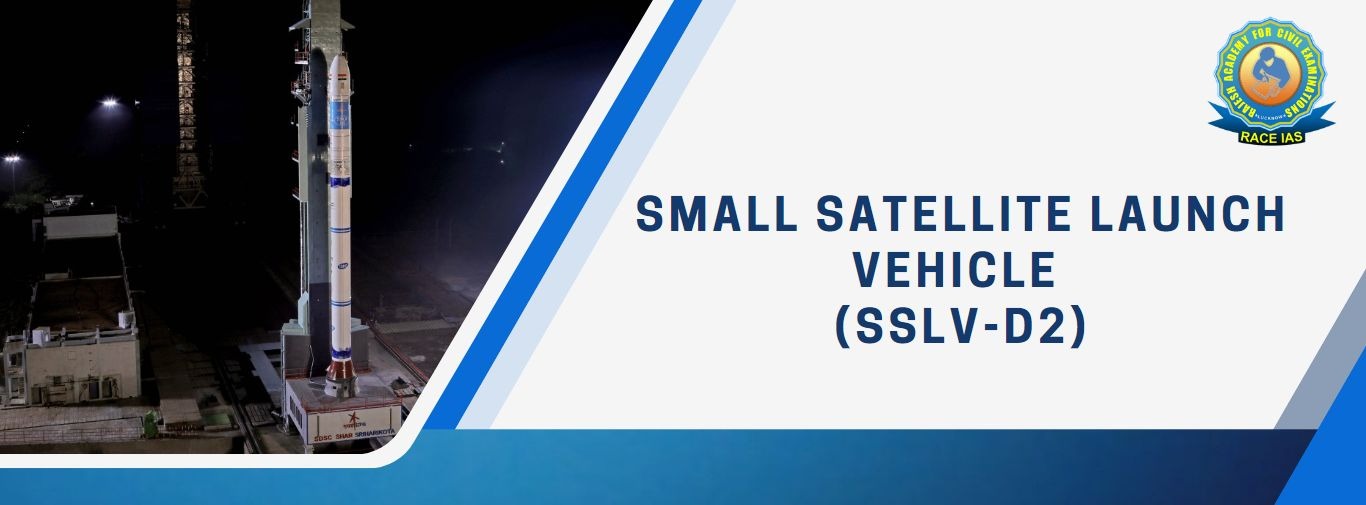
SMALL SATELLITE LAUNCH VEHICLE (SSLV-D2)
Current Affairs I Race IAS : Best IAS Coaching in Lucknow I SMALL SATELLITE LAUNCH VEHICLE (SSLV-D2) I Science and Technology
SMALL SATELLITE LAUNCH VEHICLE (SSLV-D2)
Mains General Studies: Paper- 3
(Science and Technology)
Why in News:
- Recently ISRO successfully launched its smallest rocket SSLV-D2.
- This rocket was launched on February 10, 2023 from Satish Dhawan Space Center Sriharikota, Andhra Pradesh.
Key points:
- Three satellites were also sent into space with the SSLV-D2 rocket.
EOS-07
- This satellite is built by ISRO to observe the Earth.
- Its weight is 156.3 kg.
Azadi-SAT
- The satellite is built by Chennai-based space startup SpaceKidz.
- Its weight is 8.7 kg.
- This satellite is made by 750 girl students of India.
Janus-1
- This is a satellite of the American company Antaris.
- Its weight is 10.2 kg.
- All these three satellites were placed in circular orbit 450 km apart.
- Last year also, ISRO tried to launch this rocket under the name of SSLV-D1, but it did not prove to be successful.
About SSLV-D2:
- The rocket consists of three solid propulsion stages including a liquid propulsion based Velocity Terminal Module.
- Its objective is to meet the launch on demand of commercial markets by small and micro satellites.
- It is based on placing small satellites in the Earth's orbit.
- The total weight of SSLV-D2 is about 120 tonnes.
- According to ISRO, the cost of the SSLV rocket is around Rs 56 Crore.
- Its length is 34 meters and width is 2 meters.
Characteristics:
- According to ISRO, this rocket works on the technology of launch on demand.
- It has the capability to cater to the launch of 500 kg satellites in low earth orbits.
- Its cost is very less.
- It has the capacity to accommodate more than one satellite.
- Launching of satellites requires minimum infrastructure.
- Its turn around time is very less, that is, it is able to complete the orbit in a very short time.
Significance:
- The development of small satellites will get a boost.
- Many employment opportunities will be created.
- Government and non-government organizations in the country will get an opportunity to launch small satellites for their own use.
- The demand for small satellites will increase in the coming years.
- Opportunities for business and commercial activities will increase.
- India's credibility will increase globally in the field of technology.
What is Rocket:
- A rocket is a spacecraft that propels a vehicle or payload into the air. The rocket engine produces thrust i.e. a type of force to propel an object towards the sky.
How Rocket Works:
- Like any other engine, fuel is combusted in a rocket. The rocket propels the fuel forward by pushing the gas out the back, converting the fuel into hot gas.
- Rockets have oxidisers to ignite the fuel. These oxidizers are called propellants. These propellants are available in solid and liquid form.
- Rockets move in space on the basis of 'Newton's third law of motion action-reaction'.
Rocket Type:
- On the basis of the fuel used in the rocket engine, it is mainly classified into two parts:
- Liquid Fuel Rocket: Liquid fuel is used in the engines of modern rockets. For example, the main engine of the Space Shuttle and the Russian Soyuz rocket.
- Solid Fuel Rocket: Two white colored solid propellants are used in the sides of this spacecraft. Solid fueled rockets are used in fireworks.
- Rockets based on ion and plasma are also used.
Rocket Launching:
- Satellites are always launched from the equator at higher latitudes for ease of placing them in orbits.
Uses of Rocket:
- For space flight.
- Rockets are also used to convert parachute's hard landing into soft landing.
- In the field of science and research.
- For military activities.
- In the field of sports and entertainment.
Important facts related to Rocket:
- The first use of rocket in the world was done by China in the year 1200.
- In the year 1969, with the help of Saturn V rocket, America had landed man on the moon for the first time.
- India launched its first rocket on November 21, 1963. India had taken this rocket from America.
- India launched its first indigenous rocket Rohini-75 on 20 November 1967.
- The speed of the rocket is 7.8 km/s (ie 28,100 km/h) to go into the lower orbit of the earth.
- The rocket is launched at a speed greater than the escape velocity 11.19 km/s (ie 40,284 km/h) to escape the Earth's gravity and go to another planet or moon.
Conclusion:
- This rocket launched by India's ISRO has been the first successful test of the year 2023.
- The following missions are planned to be launched by ISRO in the year 2023: Manned Space Mission 'Gaganyaan', OneWeb India-2, PSLV-C55, Reusable Launch Vehicle and NASA-ISRO SAR Mission (NISAR).
-----------------------------------------------------
Mains Exam Question:
Write about the features and importance of SSLV-D2 rocket launched by ISRO recently.